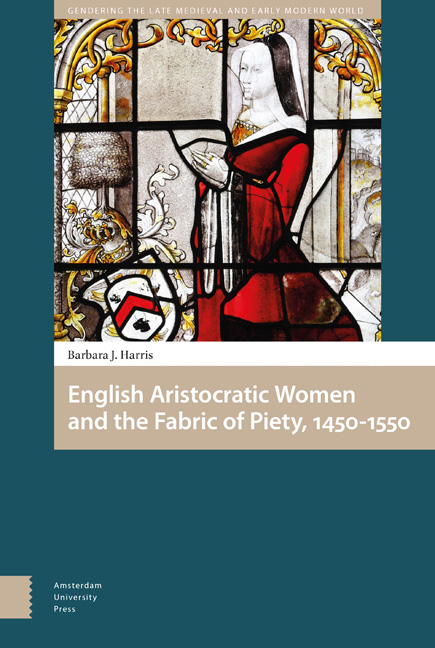Book contents
- Frontmatter
- Dedication
- Contents
- Abbreviations
- Illustrations
- Acknowledgements
- Preface
- Introduction
- 1 Tombs: Honoring the Dead
- 2 Chantries: The Quest for Perpetual Prayers
- 3 Building for the Congregation: Roofs, Aisles, and Stained Glass
- 4 Adorning the Liturgy: Luxury Fabrics and Chapel Plate
- 5 Almshouses and Schools: Prayers and Service to the Community
- 6 Defining Themselves
- 7 Epilogue: Destruction and Survival
- Conclusion
- Appendix 1 Patrons of the Fabric of the Church
- Appendix 2 Patrons of Tombs
- Appendix 3 Location of Tombs in Churches
- Appendix 4 Choice of Burial Companion
- Appendix 5 Women Who Commissioned Chantries
- Appendix 6 Commissions of Stained-Glass Windows
- Appendix 7 Additions or Major Repairs to Churches
- Appendix 8 Bequests of Vestments
- Appendix 9 Patrons of Almshouses or Schools
- Glossary
- Select Bibliography
- Archival Sources
- Index
5 - Almshouses and Schools: Prayers and Service to the Community
Published online by Cambridge University Press: 11 December 2020
- Frontmatter
- Dedication
- Contents
- Abbreviations
- Illustrations
- Acknowledgements
- Preface
- Introduction
- 1 Tombs: Honoring the Dead
- 2 Chantries: The Quest for Perpetual Prayers
- 3 Building for the Congregation: Roofs, Aisles, and Stained Glass
- 4 Adorning the Liturgy: Luxury Fabrics and Chapel Plate
- 5 Almshouses and Schools: Prayers and Service to the Community
- 6 Defining Themselves
- 7 Epilogue: Destruction and Survival
- Conclusion
- Appendix 1 Patrons of the Fabric of the Church
- Appendix 2 Patrons of Tombs
- Appendix 3 Location of Tombs in Churches
- Appendix 4 Choice of Burial Companion
- Appendix 5 Women Who Commissioned Chantries
- Appendix 6 Commissions of Stained-Glass Windows
- Appendix 7 Additions or Major Repairs to Churches
- Appendix 8 Bequests of Vestments
- Appendix 9 Patrons of Almshouses or Schools
- Glossary
- Select Bibliography
- Archival Sources
- Index
Summary
Although aristocratic women spent fortunes building chapels and altars to shorten the amount of the time they and their close kin would spend in Purgatory, they were always aware that the beloved of Christ were the poor and underprivileged rather than the rich and powerful like themselves. The ideal strategy for dealing with the problem of Purgatory was thus to create institutions—schools and almshouses—that included the prayers of the poor as well as those of the clergy. Foundations of this kind fulfilled a dual function as chantries and educational or charitable establishments. The importance that the women attached to the prayers of its members is evident from their foundation statutes, which are notable for the specificity of the prayers they required the almsmen and students to recite on a daily or annual basis. Their detailed instructions also demonstrate, once again, their knowledge of the Church's rituals and services. Although they may well have consulted their chaplains or other clergy about the liturgy, the final choice was clearly theirs. At the same time, their schools and almshouses proclaimed their role as members of the leading families in their parishes in an even more imposing way than their chapels, aisles, altars, and material gifts to churches. Their foundations were another example of the way in which both spiritual and secular motives inspired their patronage.
Establishing schools and almshouses required much larger endowments than even the most elaborate chantries. Thus, it is not surprising that a large proportion of the eighteen Yorkist and early Tudor aristocratic women who founded such institutions were heiresses and/or childless. In a period when only 12 percent of the daughters of noblemen and 7 percent of the daughters of parliamentary knights were heiresses, thirteen of the eighteen female founders of almshouses and schools studied here had inherited land. After their husbands died, they controlled their property and could use it to endow institutions that would glorify and benefit them and their families in perpetuity. In addition, eight of the eighteen founders were childless, again a high percentage at a time when 91 percent of the wives of noblemen and knights bore at least one surviving child. For these women, using their inheritances to establish schools and almshouses may have satisfied the impulse for nurturing they could not fulfill by caring for their own children.
- Type
- Chapter
- Information
- English Aristocratic Women's Religious Patronage 1450-1550 , pp. 103 - 114Publisher: Amsterdam University PressPrint publication year: 2018



